
SAFETY CAPACITY: Leadership Practices for Failing Safely
Failure is inevitable but disastrous consequences are not. Any human effort can fail. In fact, failure is a necessary step toward learning and innovation. Failure is just the occurrence of the unexpected, unintended, or unwanted, and learning and innovation are the constructive responses to these occurrences. However, when we do dangerous work—the kind of work that creates high value for companies, communities, and society—the consequences of failure can be catastrophic. The role of a safety leader is to build the organization’s capacity to do dangerous work without unacceptable consequences while also adapting to changing conditions around that work.
This book is for safety leaders. It describes six leadership practices that build safety capacity. Safety capacity is the extent to which organizations can absorb the consequences of failure. Safety capacity not only allows an organization to avoid catastrophe, it enables the organization to learn, innovate, and thrive.






